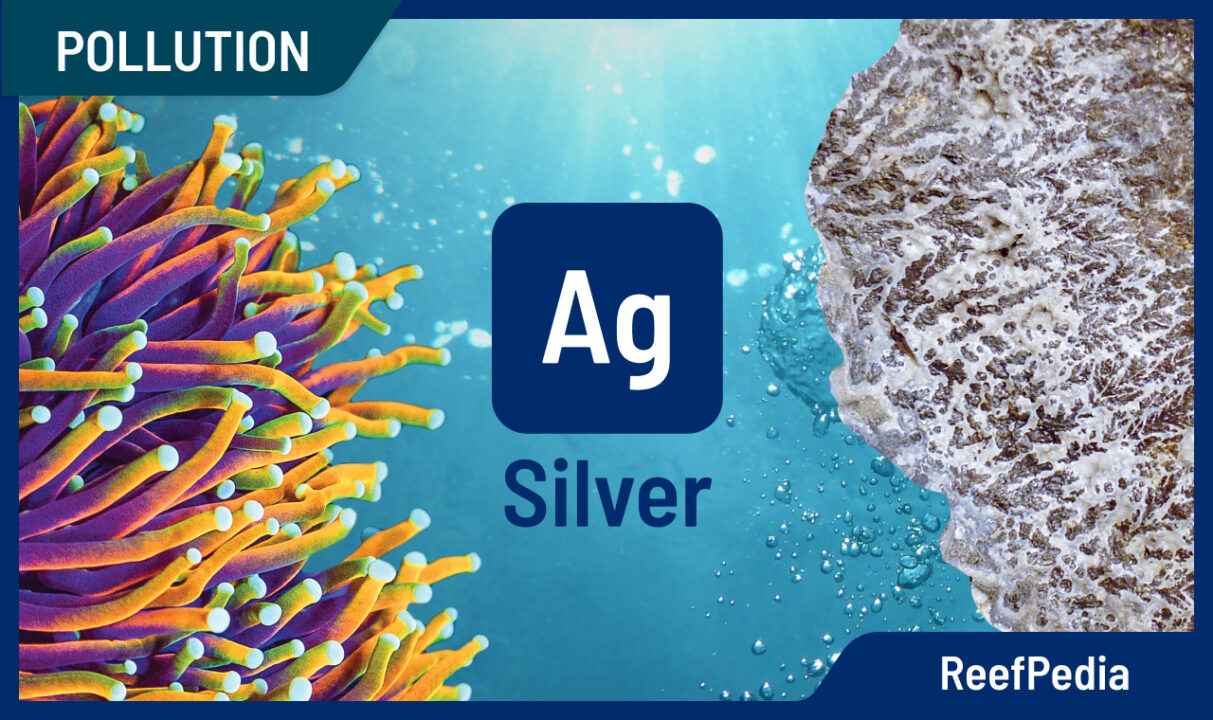Table of Contents
What is SILVER (Ag)?
Silver (Ag, Latin argentum) in its pure form is a silvery-white metal. It belongs to the group of transition metals* and has all the properties of metals, however, its chemical activity is low. It occurs in the free state and in minerals such as argentite and chlorargyrite.
Silver forms chemical compounds in which it occurs most frequently in the +I oxidation state (silver nitrate; AgNO3), much less frequently in the +II oxidation state (silver fluoride; AgF2) and the +III oxidation state (silver (III) peroxosulphate; Ag2(SO5)3).
Importance of silver in seawater
Silver is a metal that can have negative effects on marine animals. It has biocidal properties, hence it is often added to products to combat bacteria. In marine aquaristics, silver-based preparations are often used to combat cyanobacteria.
How to control cyano? – read this article to find out
Dangers of excess silver in seawater
High levels of silver in seawater are toxic to animals. It can block enzymatic reactions important to marine organisms. In general, the presence of silver in a reef tank is rare, most often precipitating as various sediments. For example, in the anaerobic zones of the aquarium, hydrogen sulphide (H2S) accumulates, which reacts with silver to precipitate a dark precipitate of silver sulphide (Ag2S) according to the following reaction (1):
4Ag + 2H2S + O2 → 2Ag2S↓ + 2H2O (1)
The use of silver-based cyanobacteria control products can disrupt the bacterial economy in the tank, as silver does not act specifically (only on cyanobacteria) but also on other bacteria, thus disrupting the nitrification cycle, among other things.
How to protect the aquarium?
Check the silver content regularly and keep it at a non-detectable level – 0 μg/L. The absence of silver in the seawater ensures healthy animals and beautiful colouration.
The most accurate and reliable method for determining silver is ICP-OES analysis. The Inductively Coupled Plasma Optical Emission Spectrometry (ICP-OES) technique is the most accurate analytical method for analysing the elemental composition of seawater.
Recommendations
In order to ensure the correct level of silver in your aquarium you should systematically test it and ensure that it is at the correct level.
If the silver level is above 0 µg/l, this can lead to health problems in corals and other animals or even death. The most common causes of exceeding the recommended silver level: low-quality plastics, ceramic pump shafts, high-grade steel. Find and eliminate the cause of the problem and lower the value of this parameter in the water. Carry out up to 6 water changes. It is recommended to change about 15% of the aquarium water volume during each change until the recommended value of this parameter is reached. The water prepared for the change must have the correct target salinity level. Use salts with the correct parameters and composition suitable for the ICP test.
*Transition metals – a group of chemical elements in the periodic table, including side groups of the periodic table, i.e. groups 3-12.
About author

Magdalena Metzler
Privately, I am a mother and a lover of nature and sport. My main interest is quantum chemistry, which hides a whole lot of unsolved mysteries and connections, which is extremely exciting from a scientific point of view.
In my scientific career, I have conducted international projects focused on innovative solutions for many branches of business, e.g. automotive, construction, and now, of course, marine aquaristics.
Working at Reef Factory gave me a passion for marine aquaristics, which I can develop every day, building a chemistry department and creating products that will help aquarists take care of tanks and ensure the highest safety of animals. One of the most exciting memories of working at Reef Factory is the commissioning of the ICP-OES spectrometer, which analyzes the elemental composition of seawater. The method of analysis in ICP is based on an analytical technique, which is a combination of my passion for quantum chemistry and marine aquaristics.
I hope you find my articles on ReefPedia interesting and helpful! Happy reading :))

